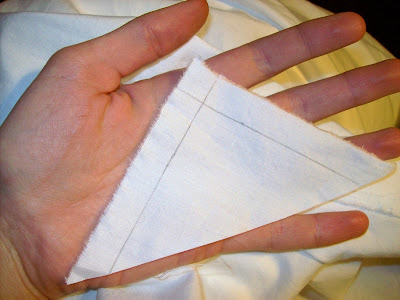Slat Bonnets (HSF Accessorize Challenge)
 |
| My newest slat bonnet, entered in the Historical Sew Fortnightly |
The perfect 19th century slat bonnet continues to elude me. I have made four so far, and am trying to come up with a pattern that has just the right proportions and looks nice. There has been much trial-and-error. My first few slat bonnets all have the same problem: the brim does not extend far enough down the side of the face. When wearing them, I discovered that the curtain will fly upward if the top edge of the curtain is higher than the chin. It seems that it works best when the brim ends exactly at the jawline. Also, the curtain should be long enough to lay on the shoulders, or at least touch the shoulders. Here are some pictures of my first three slat bonnets:
All of these bonnets are different. I have experimented with shapes and sizes of the pieces, and have at least discovered what works best for the brim and curtain. I plan to write a future blog post concerning construction details.
My latest endeavor is this white and purple flowered slat bonnet, for which I over-compensated and made it too big! The worst part is the crown, which is much, much larger than it should be. It looks somewhat like a chef's cap turned sideways. Not the look I was going for. The brim is nearly perfect; I like how it ends at the jawline and the slats are relatively wide. I think it's just a tad too long; I want the brim to be able to shade the face without acting as a blinder. I am also pleased with the way the curtain looks. I think it is a reasonable width and length, and the excess gathers in the back make it lay nicely over the back and shoulders. Though this bonnet looks ridiculous, it will suffice for now, and I learned a lot from it.
Here are the details for the Historical Sew Fortnightly (http://thedreamstress.com/the-historical-sew-fortnightly/), as this bonnet is my entry for Challenge #7: Accessorize, due April 8th.
The Challenge: #7: Accessorize -- a 19th century slat bonnet
Fabric: 100% cotton calico
Pattern: my own
Year: mid 19th century
Notions: thread
How historically accurate is it? Very accurate; it is completely hand-sewn with cotton thread using historic stitching techniques. I have done a lot of research about work bonnets, and have aspired to meet the standards of what I have learned through my research.
Hours to complete: perhaps 10
First worn: hopefully next weekend
Total cost: free--the fabric was given to me












This one looks really good to me! It doesn't look too poofy in the crown at all.
ReplyDeleteReally?! Thanks! The excess space in the crown makes the bonnet slip forward on my head, so I really want to remedy the problem even if it looks okay. I appreciate your compliment!
DeleteI never thought of that happening! :p Maybe it would help when you have your hair up in back. I have a corded sheer bonnet, and my hair kind of anchors it where it ties at the base of the crown. Also, Elizabeth Stewart Clark has a PDF handout on her website on making a slat bonnet; maybe she has some tips. But honestly, it looks very good! If you want, you can make the curtain even longer next time. Sometimes they were extremely long, almost to the elbow. It makes sense when you realize how much a dress fades on the shoulders and back, and the bonnet protects right there.
DeleteThank you very much for the feedback and advice! I would like to try making a longer curtain, now that you've suggested it.
Delete